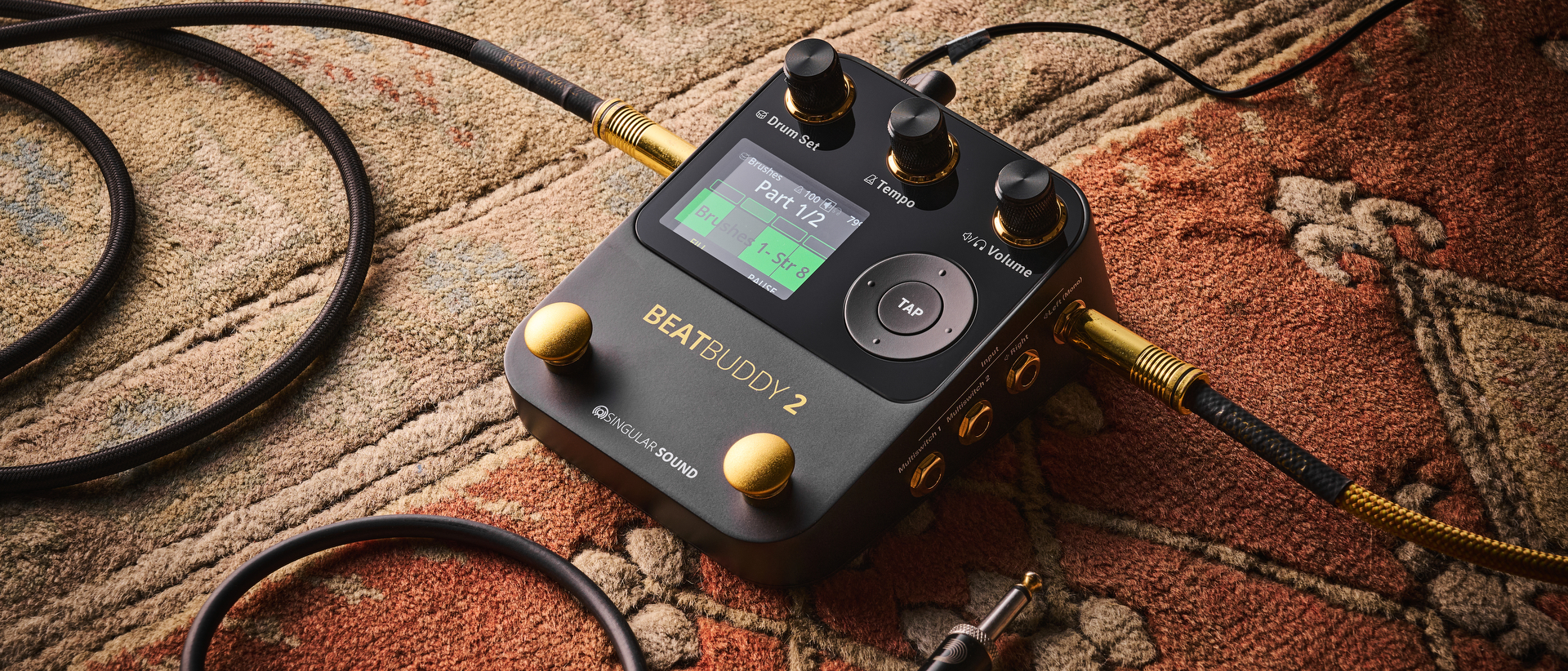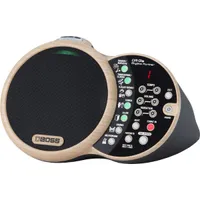Guitar World Verdict
If you’re looking to play at home or gig without having to rely on an actual drummer, the Singular Sound BeatBuddy 2 is a fantastic choice. It improves on the original in nearly every way, and although it’s probably not what you would use for recording, the quality of the sounds is absolutely fantastic, easily the class in the field of what’s available now in terms of pedalboard-friendly drum machines.
Pros
- +
Super easy to use.
- +
Pedalboard-friendly format.
- +
Very sturdy build quality.
- +
Screen is bright and clear.
Cons
- -
Needs a full-range speaker for optimal sound.
- -
You have to use a computer to make your own patterns.
You can trust Guitar World
What is it?
Following on from the success of the original, crowdfunded Beat Buddy pedal, the Singular Sound BeatBuddy 2 is back to give guitarists a flexible drum machine in a pedalboard-friendly enclosure. It’s been some 11 years since the original launched, yet despite this, the market for ‘board-mounted drum machines is still pretty small.
A tool equally adept at home practice as it is for live performances, BeatBuddy 2 improves on nearly every aspect of the original with an improved screen, better usability, greater connectivity, a redesigned chassis and enhanced drum sounds. It’s a laundry list of user requests from the first edition made real, showing that Singular Sound has been listening to its user base.
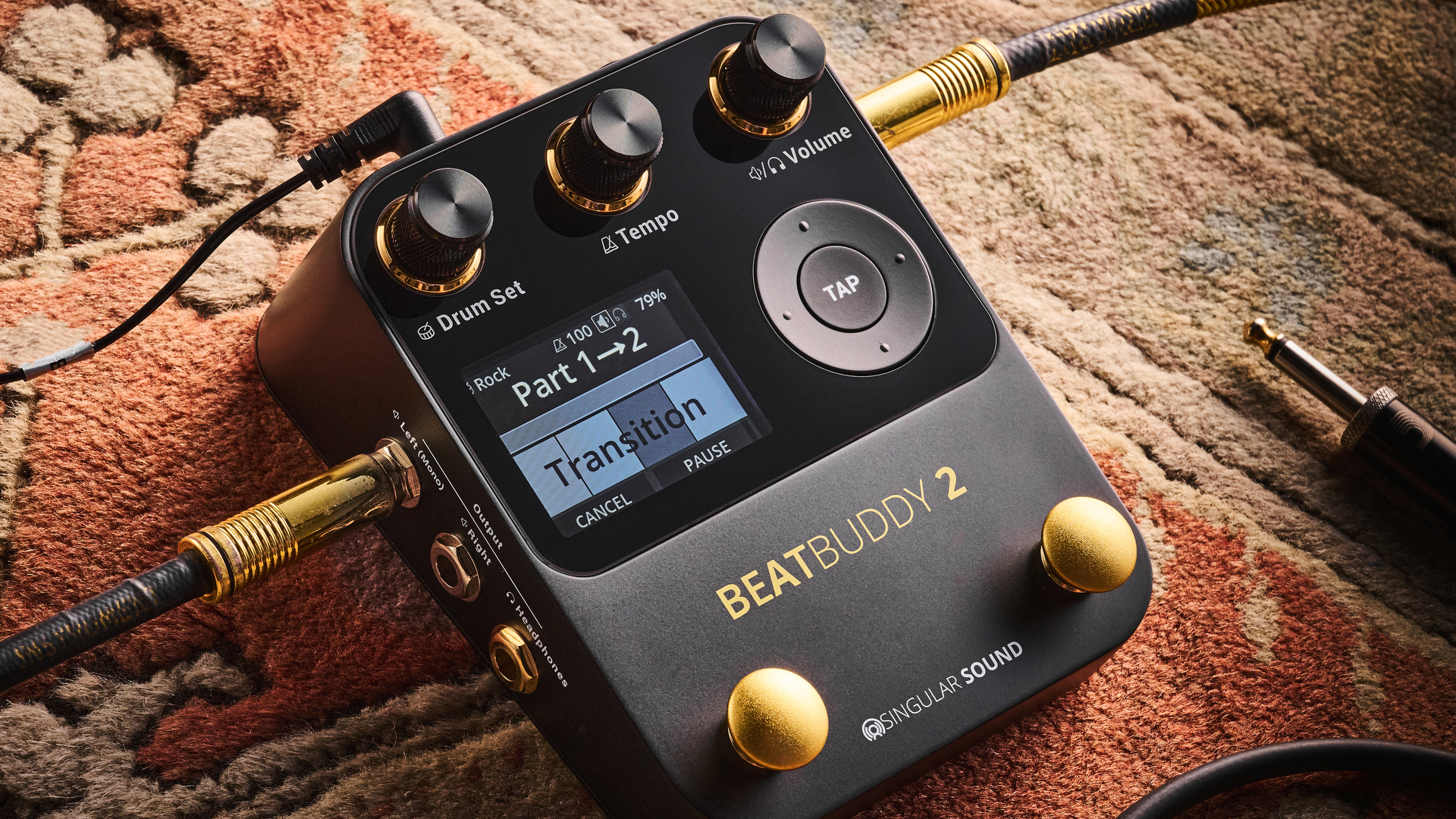
Included with the BeatBuddy 2 is a 4GB SD card, which contains all of the stock beats and room to add your own. You can upgrade the card anywhere up to 32GB if you want, which will be a colossal amount of rhythms if you were ever to fill it up. Used in conjunction with the Beat Buddy Manager Online, you can create your own songs with up to 32 different parts, import other projects, and import drum sounds.
Specs
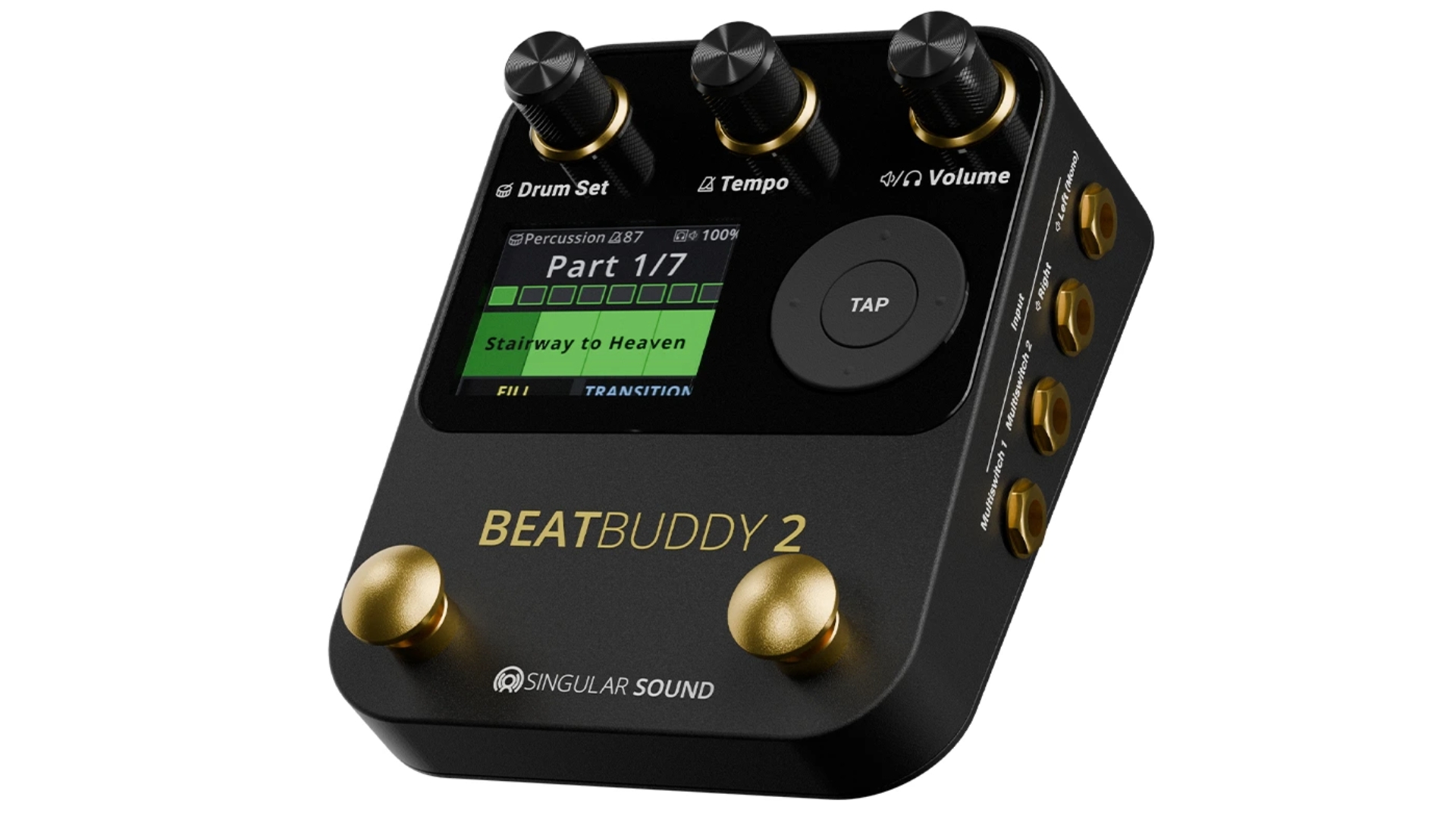
- Launch price: $599
- Type: Drum machine pedal
- Controls: Volume, drum set, tempo, tap tempo, directional controls
- Features: 24-bit 44.1kHz audio, up to 32GB storage space, 1.77" Diagonal TFT RGB (128x160) screen
- Connectivity: 2 x 1/4" TS ins, 3 x 1/4" outs, 2 x 1/4" TRS footswitch,
- Bypass: N/A
- Power: 9V DC Power Supply (Included), 300mA
- Dimensions: 2.5 x 3.5 x 5.1”
- Weight: 1.1lbs (0.49kg)
- Options: N/A
- Contact: Singular Sound
Build quality

Build quality rating: ★★★★★
The BeatBuddy 2 clearly takes the idea of being built like a tank very seriously, and is amongst the sturdiest feeling stompboxes I’ve tested in the past couple of years. In my hand, it has a hefty weight for its size, making it a big chunk of stompbox. As it’s designed to be stomped on a lot, this is definitely a tick in the plus column.
The new black and gold livery is much classier than the generic grey of the original pedal, giving it a much more premium look to match that not insignificant price point. Across the top panel, three chunky knurled knobs (which also act as buttons) control the major functions. They’re all notched, which gives you a bit of feedback when you turn them, and they’re very solidly attached.

It’s a similar story with the dual gold momentary footswitches, which offer a similarly reassuring robustness to them. They sit at the bottom of the pedal’s quite extreme wedge shape, making them nice and easy to stomp but also allowing me to gently manipulate the knobs with my foot, too.
All the latest guitar news, interviews, lessons, reviews, deals and more, direct to your inbox!
Usability
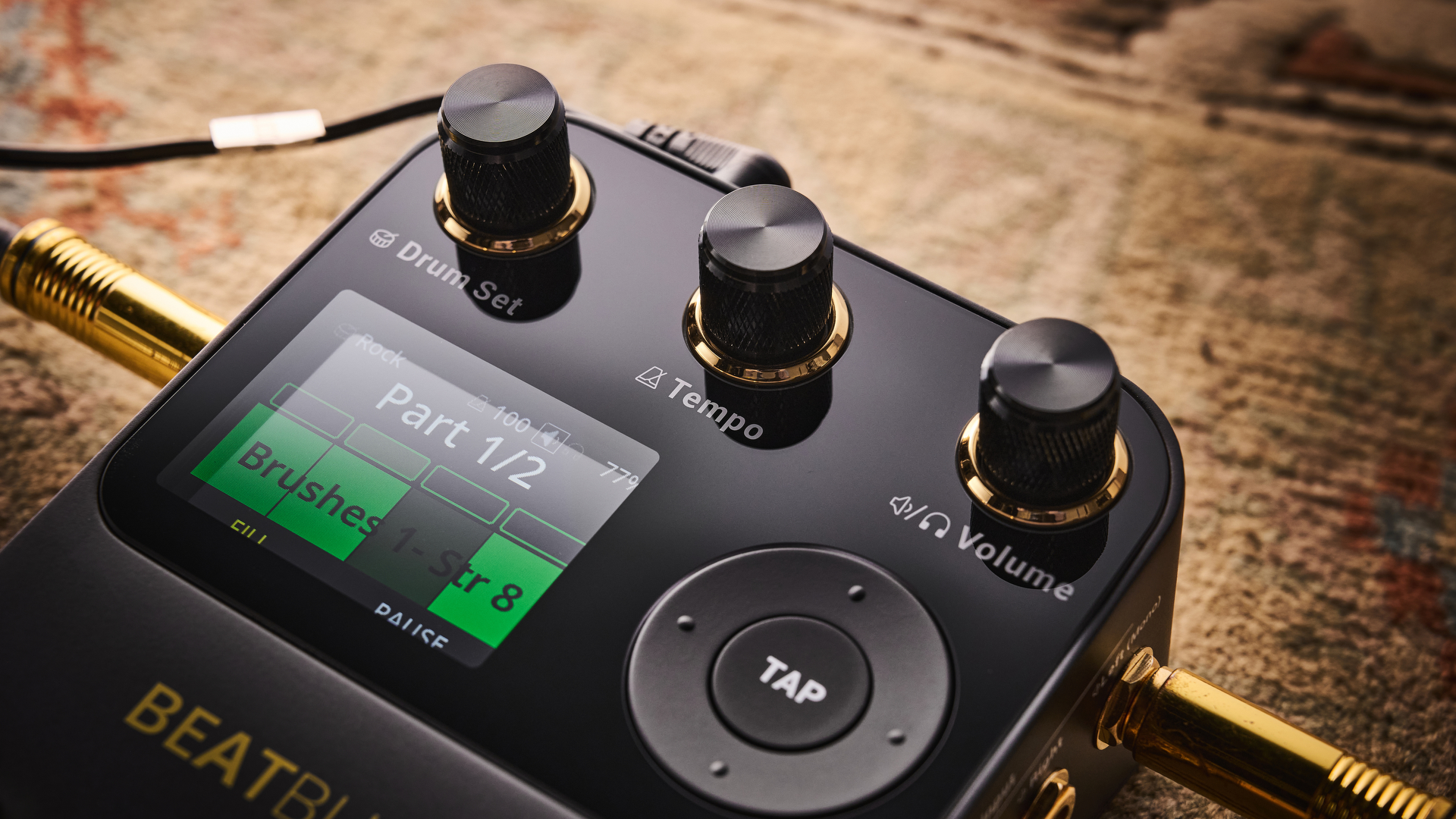
Usability rating: ★★★★☆
The pedal is well labelled, and it doesn’t take me long to work out what each of the footswitches does
Getting started with the pedal, I plug into my Spark Live full-range speaker as requested by the manual for the best sound quality, running it separately alongside a Gretsch CVT I’m also reviewing, into my pedalboard, and then on to my tube amp.
You can run your guitar and pedals through the BeatBuddy 2 if you wish, but it needs to be at the end of the signal chain so your pedals don’t affect the tone. If you’re going into a guitar amp, then any color or EQ on your amp is going to go onto the drum sounds, so for my use case, it made sense to run it separately from my amp.
The pedal is well labelled, and it doesn’t take me long to work out what each of the footswitches does. Rather like a two-button looper pedal, the stomp on the left controls most of the drum functions, starting the beats with a single stomp, adding a fill when I hit it while the beat is playing, transitioning to a second beat when I hold it down, and then finally, ending the song with a double tap.

Having this immediate control is what made the original BeatBuddy a success, and it’s easy for me to get into laying down beats to play along with. The tap tempo switch makes it quick to change the tempo on the fly, and you can also use the dedicated tempo knob to set something more exacting, which also allows for quick selection of different beats when you push it in.
The beats are split into parts that are changed by holding down the left footswitch. Some of the stock sounds have differing numbers of parts, but you can customize this in the management software. This means you can get a line structure that you can change on the fly, going long where you need or shortening a section if you feel like it’s not hitting right. It’s amazing fun to play around with, especially when you start adding fills that vary in their style and their intensity.
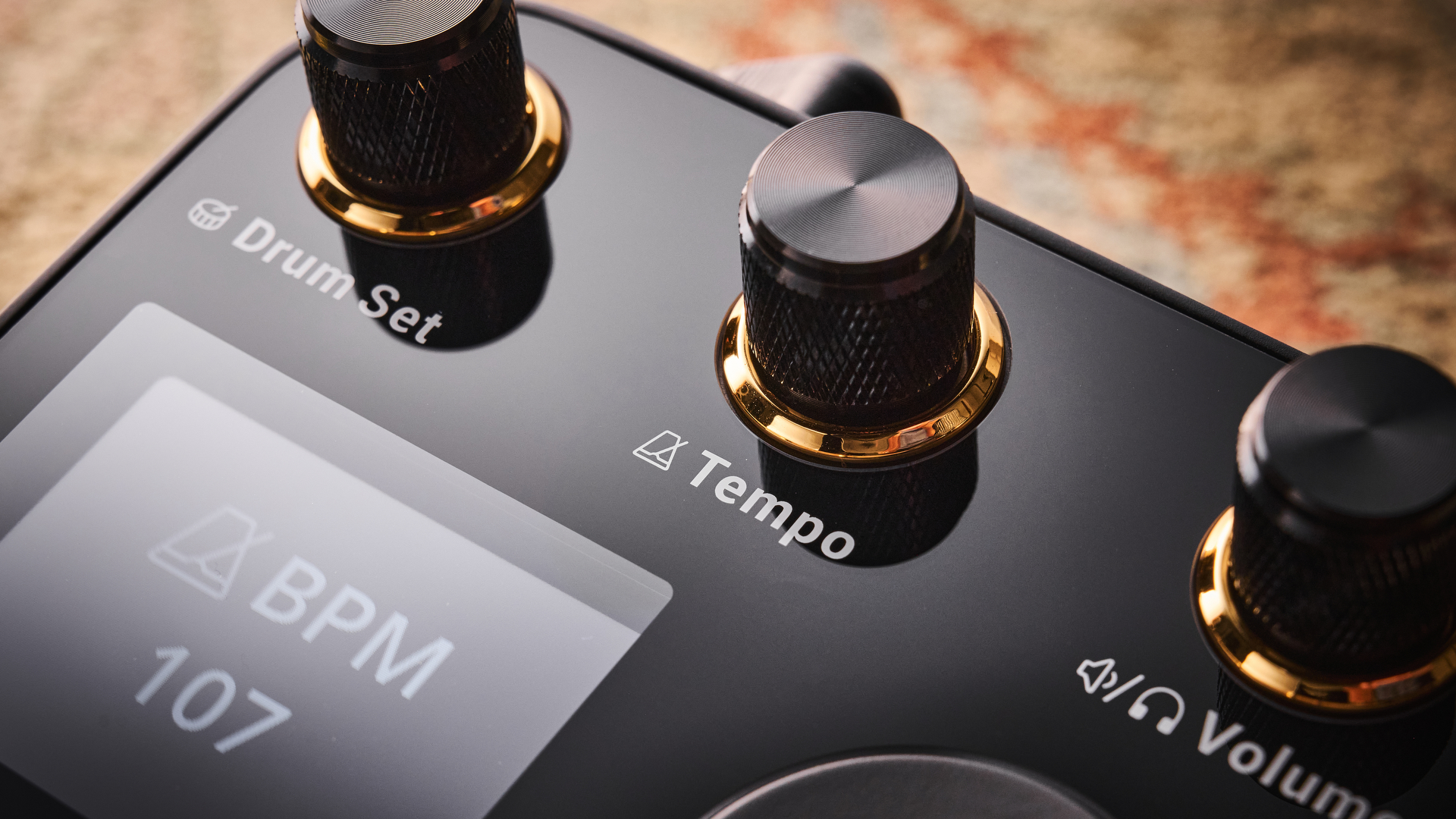
All of the beats I used only have three fills, which to the Western songwriting brain might seem like an odd choice initially. It actually makes a lot of sense when you consider the transitions to different parts feature longer, four-bar fills. This way, you can build the tension with a few different fills before you launch into a larger one to change the feel of the rhythm as you move towards the next section.
Using the BeatBuddy Manager Online allows you to customize songs with a main beat, drum fills, transitions, and accent hits. You can add up to 32 different parts to a song and customize the fills you want, making it a potentially very powerful tool for creating drum tracks to play your songs along to. I like that it works in the browser, and that I don’t have to add yet another app to my hugely cluttered smartphone, too.
Weirdly, when I began using the software, nothing on my SD card was named, which unfortunately made it pretty much unusable, as I had no idea what I was selecting to add to my song. This may be because I got the pedal into review pre-release, so the software didn’t recognize it, or I got a pre-release SD card that hadn’t been finalized yet. Either way, I wasn’t able to utilize the software to its full potential.
Sounds
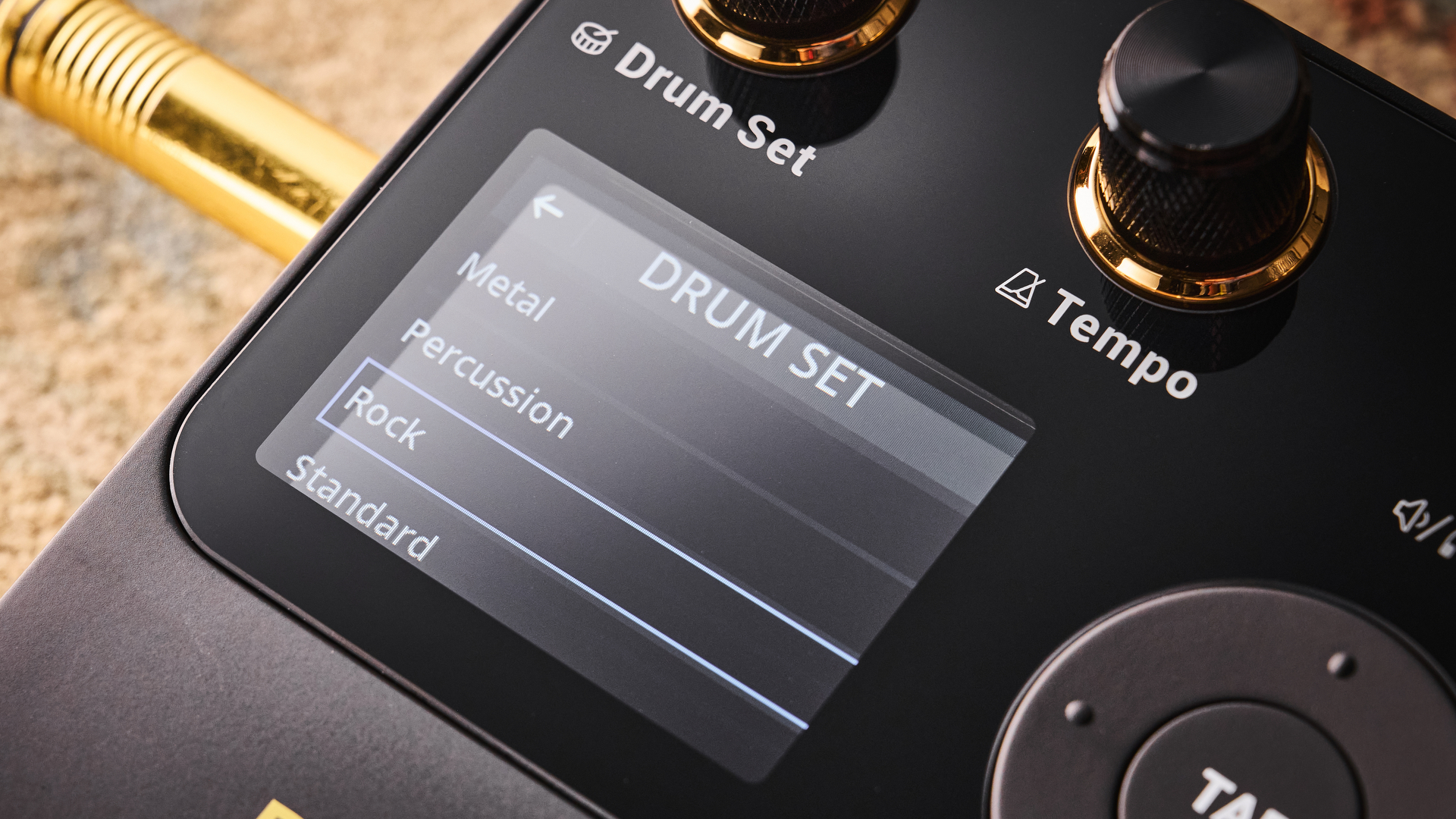
Sounds rating: ★★★★½
The sound quality of the BeatBuddy 2 is really rather good, especially when compared to the built-in beats I’ve found on various looper pedals from more established brands. The drum sounds here are crisp and sharp, not quite drum recording territory but certainly good enough for practice or live performance.
Of course, the sound reproduction is dependent on what medium you play it through, but in my test, it sounded fantastic through the FRFR Positive Grid Spark Live. You can play it through your amp, but you lose the punchiness of the kick drum and the shimmer of the cymbals this way, and of course, if you use any overdrive or reverb on your amp, you’ll also subject your beats to that.
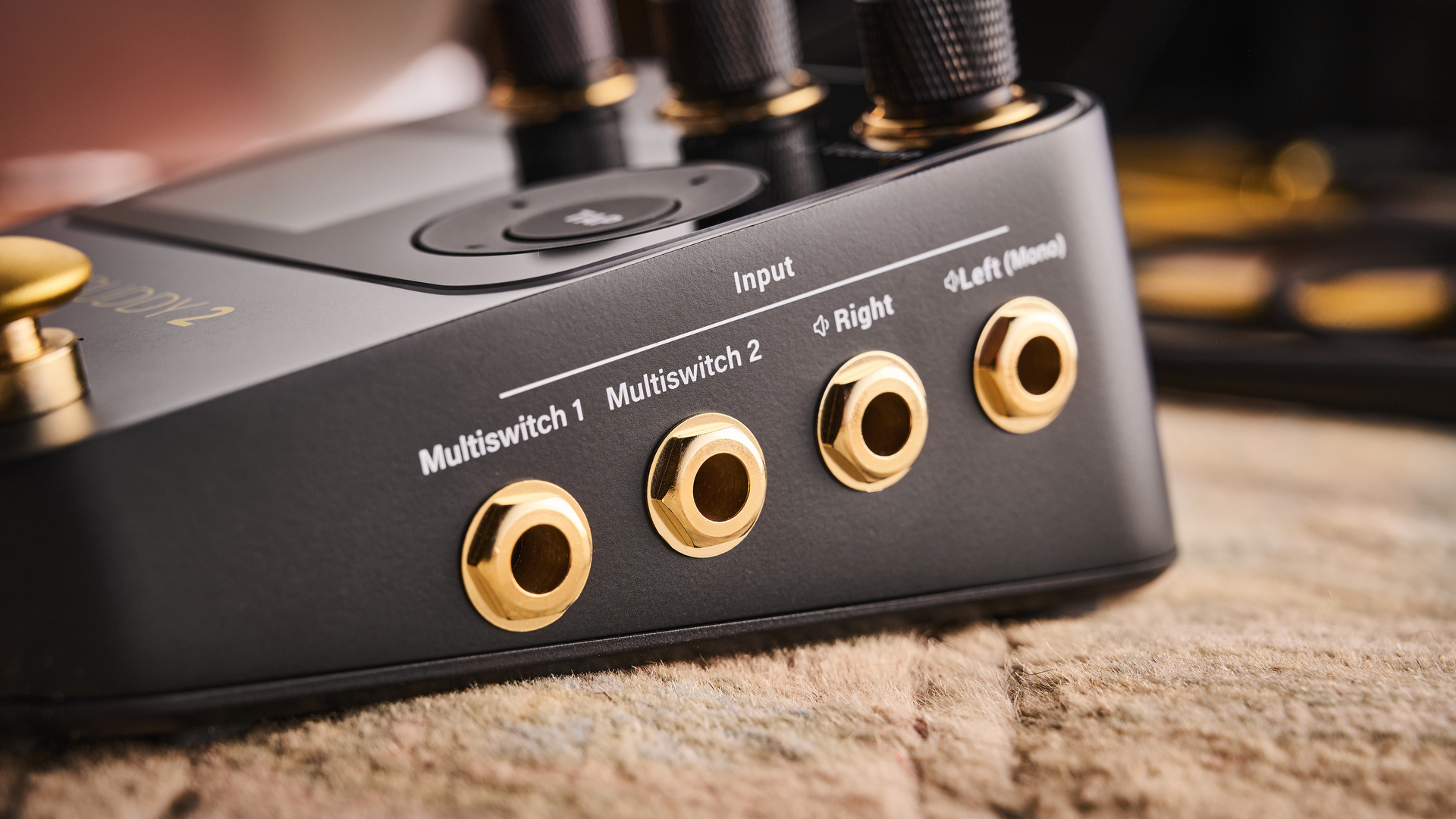
It’s very much that modern produced drum sound, and honestly, it’s amongst the best quality I’ve ever heard from any built-in rhythms on any pedal.
There’s a noticeable difference between the regular kits and the new HD ones, three of which are included as stock on the pedal. They sound much more natural, with huge-sounding kicks, snares and cymbals that ring out very realistically. It’s very much that modern produced drum sound, and honestly, it’s amongst the best quality I’ve ever heard from any built-in rhythms on any pedal.
The ability to export the beat in true stereo is another welcome addition, although you’re far more likely to get use out of this at home than you would on the live circuit. It sounds great in mono, of course, but adding that stereo element really helps open up the spread of the drums, with an excellent soundstage and use of the stereo field. This is especially noticeable when you use the headphones out or a nice pair of studio monitors.
Verdict
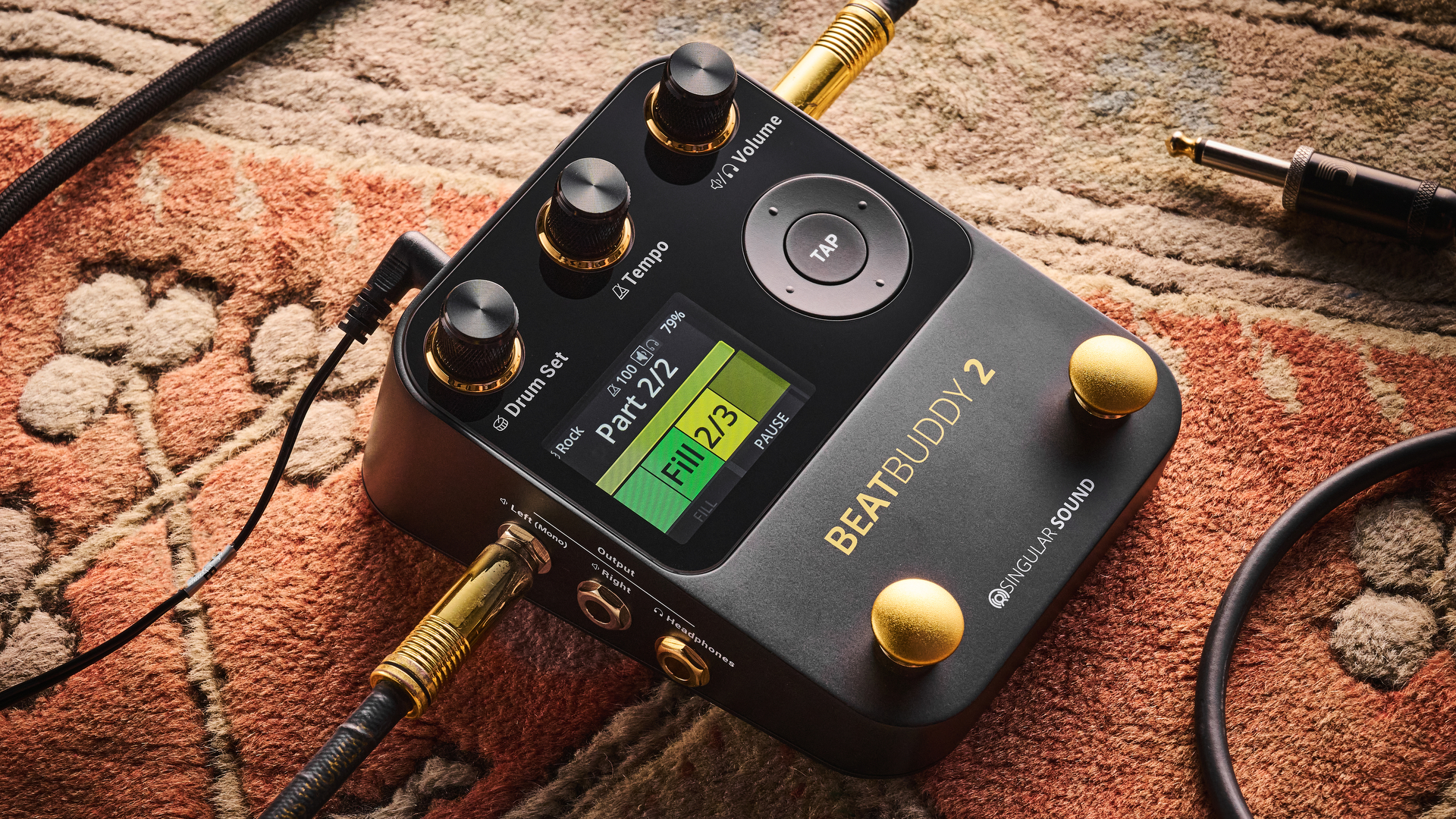
The fact that it sounds much better through an additional speaker versus a traditional guitar amp may also put some guitarists off
The Singular Sound BeatBuddy 2 is a really clever bit of kit that makes playing along with drum beats an absolute breeze. Instead of trying to squeeze loads of features in, Singular Sound has kept things nice and simple here, allowing you to concentrate on actually playing and having fun coming up with new ideas or practicing technique.
It is annoying that you can’t chain parts or beats just by using the pedal, though, especially as there are controls here doubling up to do the same function, which to me seems like a missed opportunity. The fact that it sounds much better through an additional speaker versus a traditional guitar amp may also put some guitarists off who are looking for an all-in-one solution.
Guitar World verdict: If you’re looking to play at home or gig without having to rely on an actual drummer, the Singular Sound BeatBuddy 2 is a fantastic choice. It improves on the original in nearly every way, and although it’s probably not what you would use for recording, the quality of the sounds is absolutely fantastic, easily the class in the field of what’s available now in terms of pedalboard-friendly drum machines.
Test | Results | Score |
|---|---|---|
Build quality | Rugged build that’s more than capable of putting up with gigging abuse | ★★★★★ |
Usability | It’s really simple to use, but you do need to use software to get the most out of it | ★★★★☆ |
Sounds | It won’t replace your drum VST but the sounds here are easily the best I’ve heard from a guitar pedal | ★★★★½ |
Overall | A brilliant pedal for practicing, songwriting, or performing with | ★★★★½ |
Also try
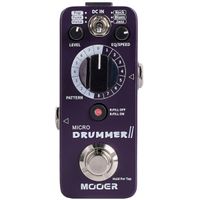
Mooer Micro Drummer II
$79/£79
If you want a drum machine in a pedal even smaller than the BeatBuddy 2, then have a look at the Mooer Micro Drummer II. It’s compact and cheap yet does a pretty good job of filling the role of impromptu drummer. There are plenty of patterns available, tap tempo, plus a simple EQ for altering the tone of the drum patterns.
Boss DR-01S Rhythm Partner
$295.99/£216
More designed for singer-songwriters, the Boss DR-01S Rhythm Partner features some amazing-sounding drums and plenty of patterns to play with. It’s not for pedalboard users due to the weird shape and large size, but if you need something to accompany you on stage with an acoustic guitar, it’s one of the best-sounding drum machines out there.
Digitech Trio+
$399.99/£279
Okay, so the Digitech Trio+ isn’t actually a drum machine pedal, but what it does is respond to your playing and build a drum pattern that matches the style and intensity. It’s a very clever bit of kit and a great songwriting tool for players who don’t have a drummer and bassist to play along with.
Read more: Digitech Trio+ review

Matt is a Junior Deals Writer here at Guitar World. He regularly tests and reviews music gear with a focus on guitars, amps, pedals, modelers, and pretty much anything else guitar-related. Matt worked in music retail for 5 years at Dawsons Music and Northwest Guitars and has written for various music sites including MusicRadar, Guitar Player, Guitar.com, Ultimate Guitar, and Thomann’s t.blog. A regularly gigging guitarist with over 20 years of experience playing live and writing and recording in bands, he's performed everything from jazz to djent, gigging all over the country in more dingy venues than you can shake a drop-tuned guitar at.
You must confirm your public display name before commenting
Please logout and then login again, you will then be prompted to enter your display name.
